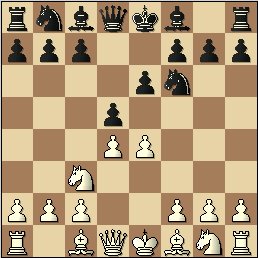
1.e4 1.d4 has the threat of 2.e4. After 1.e4, the threat is 2.d4 1...e6 There's no immediate effort to counter in the center or to prevent white from playing 2.d4 2.d4 No reason to avoid this move. White establishes control over the key squares in the center of the board. 2...d5 This is the main idea. On 3.exd4? black will recapture with exd4 gaining a presence in the center and good potential movement for both bishops. 3.Nc3 There are other moves for white here, notably 3.e5 and 3.Nd2, but this is the move I have always used. White adds to the tension in the center, adding an attack to the d5-pawn and depending the e4-pawn. 3...Nf6 Diagram
|
Armed with that information, you will have an easier time understanding the following game, a win of mine from the 10th United States Correspondence Chess Championship.
1.e4 e6 2.d4 d5 3.Nc3 Nf6 4.Bg5 Be7 5.e5 Nfd7 6.Bxe7 Qxe7 7.f4 0-0 8.Nf3 c5 9.dxc5 Nc6 10.Bd3 f6 11.exf6 Qxf6 12.g3 Nxc5 13.0-0 Bd7 14.Qd2 Nxd3 15.cxd3 e5 16.Rae1 Bh3 17.Rf2 exf4 18.Nxd5 Qd6 19.Nxf4 Bg4 20.Qe3 Rae8 21.Qxe8 Rxe8 22.Rxe8+ Kf7 23.Re4 h6 24.Nh4 Diagram
Finally, here are some additional games in the same line.